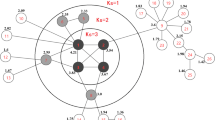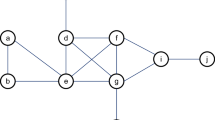Abstract
The identification of the influential nodes in a network is of great significance for understanding the features of the network and controlling the complexity of networks in society and in biology. In this paper, we propose a novel centrality measure for a node by considering the importance of edges and compare the performance of this method with existing seven topological-based ranking methods on the Susceptible-Infected-Recovered (SIR) model. The simulation results for four different types of real networks show that the proposed method is robust and exhibits excellent performance in identifying the most influential nodes when spreading starting from both single origin and multipleorigins simultaneously.
Similar content being viewed by others
References
Pastor-Satorras R, Vespignani A. Epidemic spreading in scale-free networks [J]. Phys Rev Lett, 2001, 86: 3200–3203.
Borge Holthoefer J, Moreno Y. Absence of influential spreaders in rumor dynamics [J]. Phys Rev E, 2012, 85: 026116.
Marcelino J, Kaiser M. Critical paths in a metapopulation model of H1N1: Efficiency delaying influenza spreading through flight cancellation [J]. PLOS Curr, 2012, 4(19): p.e4f8c9a2e1fca8.
Jin S, Li Y, Pan R, et al. Characterizing and controlling the inflammatory network during influenza a virus infection [J]. Scientific Reports, 2014, 4: 3799.
Klemm K, Serrano M, Eguiluz V, et al. A measure of individual role in collective dynamics: spreading at criticality [J]. Scientific Reports, 2012, 2: 292.
Tan J, Zou X. Complex dynamical analysis of a coupled system from innate immune responses[J]. International Journal of Bifurcation and Chaos, 2013, 23(11): 1350180.
Hébert-Dufresne L, Allard A, Young J G, et al. Global efficiency of local immunization on complex networks [J]. Scientific Reports, 2013, 3(2171): 1–8.
Wuellner D R, Roy S, Souza R M D. Resilience and rewiring of the passenger airline networks in the United States [J]. Phys Rev E, 2010, 82: 056101.
Albert R, Jeong H, Barabási A L. Error and attack tolerance of complex networks [J]. Nature, 2000, 406: 378–382.
Tan J, Zou X, Optimal control strategy for abnormal innate immune response [J]. Computational and Mathematical Methods in Medicine, 2015, 2015: 386235.
Holman A G, Davis P J, Foster J M, et al. Computational prediction of essential genes in an unculturable endosymbiotic bacterium, Wolbachia of Brugiamalayi [J]. BMC Microbiology, 2009, 9:243–257.
Lamichhane G, Zignol M, Blades N J, et al. A postgenomic method for predicting essential genes at subsaturation levels of mutagenesis: application to mycobacterium tuberculosis [J]. PNAS, 2003, 100(12): 7213–7218.
Li Y, Jin S, Lei L, et al. Deciphering deterioration mechanisms of complex diseases based on the construction of dynamic networks and systems analysis [J]. Scientific Reports, 2015, 5:9283.
Freeman L C. A set of measures of centrality based upon betweenness [J]. Sociometry, 1977, 40: 35–41.
Jeong H, Mason S P, Barabási A L, et al. Lethality and centrality in protein networks [J]. Nature, 2001, 411:41–42.
Liu Y Y, Slotine J J, Barabási A L. Controllability of complex networks [J]. Nature, 2011, 473(7346): 167–173.
Kitsak M, Gallos L K, Havlin S, et al. Identifying influential spreaders in complex networks [J]. Nature Physics, 2010, 6:888–893.
Zeng A, Zhang C J. Ranking spreaders by decomposing complex networks [J]. Physics Letters A, 2013, 337(14): 1031–1035.
Chen D B, Lü LY, Shang M S, et al. Identifying influential nodes in complex networks [J]. Physica A, 2012, 391: 1777–1787.
Gao S, Ma J, Chen Z M, et al. Ranking the spreading ability of nodes in complex networks based on local structure [J]. Physica A, 2014, 403:130–147.
Bae J, Kim S. Identifying and ranking influential spreaders in complex networks by neighborhood coreness[J]. Physica A, 2014, 395:549–559.
Huberman B A, Adamic L A. Growth dynamics of the-World-Wide Web [J]. Nature, 1999, 401:131–132.
Faloutsos M, Faloutsos P, Faloutsos C. On power-law relationships of the internet topology [J]. Comput Commun Rev, 1999, 29:251–262.
Khanin R, Wit E. How scale-free are biological networks [J]. J Comput Biol, 2006, 13(3): 810–818.
Noort V V, Snel B, Huynen M A. The yeast coexpression network has a small-world, scale-free architecture and can be explained by a simple model [J]. EMBO Reports, 2004, 5: 280–284.
Jeong H, Tombor B, Albert R, et al. The large scale organization of metabolic networks [J]. Nature, 2000, 407:651–654.
Albert R, Barabási A L. Statistical mechanics of complex networks [J]. Reviews of Modern Physics, 2002, 74:47–97.
Xie N. Social Network Analysis of Blogs [D]. Bristol: University of Bristol, 2006.
Newman M E J. Finding community structure in networks using the eigenvectors of matrics [J]. Phys Rev E, 2006, 74: 036104.
Spring N, Mahajan R, Wetherall D, et al. Measuring ISP topologies with rocketfuel [J]. IEEE/ACM Trans Netw, 2004, 12:2–16.
Watts D J, Strogatz S H. Collective dynamics of “small-world” networks [J]. Nature, 1998, 393: 440–442.
Chung F, Lu L, Dewey T G, et al. Duplication models for biological Networks [J]. J Comput Biol, 2003, 10(5): 677–687.
Clauset A, Shalizi C R, Newman M E J. Power-law distributions in empirical data [J]. SIAM Review, 2009, 51: 661–703.
Dickmann O, Heesterbeek J A P. Mathematical Epidemiology of Infectious Diseases: Model Building, Analysis and Interpretation [M]. New York: Wiley Press, 2000:297–298.
Zhang W, Zou X. A new method for detecting protein complexes based on the three node cliques [J]. IEEE/ACM Trans Comput Biol Bioinform, 2014, 99.1, doi: 10.1109/TCBB.2014.2386314.
Capocci A, Servedio V D P, Caldarelli G, et al. Detecting communities in large networks [J]. Physica A, 2005, 352: 669–676.
Author information
Authors and Affiliations
Corresponding author
Additional information
Foundation item: Supported by the Research Foundation of Hubei Province Department of Education (Q20151505) and the East China Jiaotong University Doctor Scientific Research Start Fund Project (26441021)
Biography: ZHANG Wei, male, Ph.D., research direction: computational system biology, complex network.
Rights and permissions
About this article
Cite this article
Zhang, W., Xu, J. & Li, Y. A new method for identifying influential nodes and important edges in complex networks. Wuhan Univ. J. Nat. Sci. 21, 267–276 (2016). https://doi.org/10.1007/s11859-016-1170-9
Received:
Published:
Issue Date:
DOI: https://doi.org/10.1007/s11859-016-1170-9




